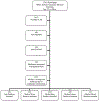Modest wine drinking and decreased prevalence of suspected nonalcoholic fatty liver disease
- PMID: 18454505
- PMCID: PMC6658188
- DOI: 10.1002/hep.22292
Modest wine drinking and decreased prevalence of suspected nonalcoholic fatty liver disease
Abstract
People at risk for coronary heart disease are often at risk for nonalcoholic fatty liver disease (NAFLD). The association of modest wine consumption with NAFLD has not been studied and the recommendation of wine for patients at risk for both diseases is controversial. The aim is to test the hypothesis that modest wine consumption is associated with decreased prevalence of NAFLD. We included Third National Health and Nutrition Examination Survey participants who either reported no alcohol consumption or preferentially drinking wine with total alcohol consumption up to 10 g per day. Suspected NAFLD was based on unexplained serum alanine aminotransferase (ALT) elevation over the cut point of the reference laboratory (ALT > 43) and the cut point based on the 95th percentile of healthy subjects (ALT > 30 for men; ALT > 19 for women). Multivariate analysis was adjusted for age, gender, race, neighborhood, income, education, caffeine intake, and physical activity. A total of 7,211 nondrinkers and 945 modest wine drinkers comprised the study sample. Based on the reference laboratory cut point, suspected NAFLD was observed in 3.2% of nondrinkers and 0.4% of modest wine drinkers. The adjusted odds ratio was 0.15 (95% confidence interval, 0.05-0.49). Using the healthy subject cut point, suspected NAFLD was observed in 14.3% of nondrinkers and 8.6% of wine drinkers. The adjusted odds ratio was 0.51 (95% confidence interval, 0.33-0.79).
Conclusion: Modest wine consumption is associated with reduced prevalence of suspected NAFLD. The current study supports the safety of one glass of wine per day for cardioprotection in patients at risk for both coronary heart disease and NAFLD.
Conflict of interest statement
Potential conflict of interest: The funders did not participate in the design and conduct of the study; collection, management, analysis, and interpretation of the data; and preparation, review, or approval of the manuscript. The authors have no financial conflicts of interest.
Comment in
-
Who is benefited by one daily glass of wine?Hepatology. 2008 Sep;48(3):1022-3; author reply 1023-4. doi: 10.1002/hep.22466. Hepatology. 2008. PMID: 18756480 No abstract available.
References
-
- Goldberg IJ, Mosca L, Piano MR, Fisher EA. AHA science advisory: wine and your heart: a science advisory for healthcare professionals from the Nutrition Committee, Council on Epidemiology and Prevention, and Council on Cardiovascular Nursing of the American Heart Association. Circulation 2001;103:472–475. - PubMed
-
- Ioannou GN, Weiss NS, Boyko EJ, Mozaffarian D, Lee SP. Elevated serum alanine aminotransferase activity and calculated risk of coronary heart disease in the United States. HEPATOLOGY 2006;43:1145–1151. - PubMed
-
- Ruhl CE, Everhart JE. Determinants of the association of overweight with elevated serum alanine aminotransferase activity in the United States. Gastroenterology 2003;124:71–79. - PubMed
-
- Thun MJ, Peto R, Lopez AD, Monaco JH, Henley SJ, Heath CW Jr, et al. Alcohol consumption and mortality among middle-aged and elderly U.S. adults. N Engl J Med 1997;337:1705–1714. - PubMed
Publication types
MeSH terms
Substances
Grants and funding
LinkOut - more resources
Full Text Sources
Medical

